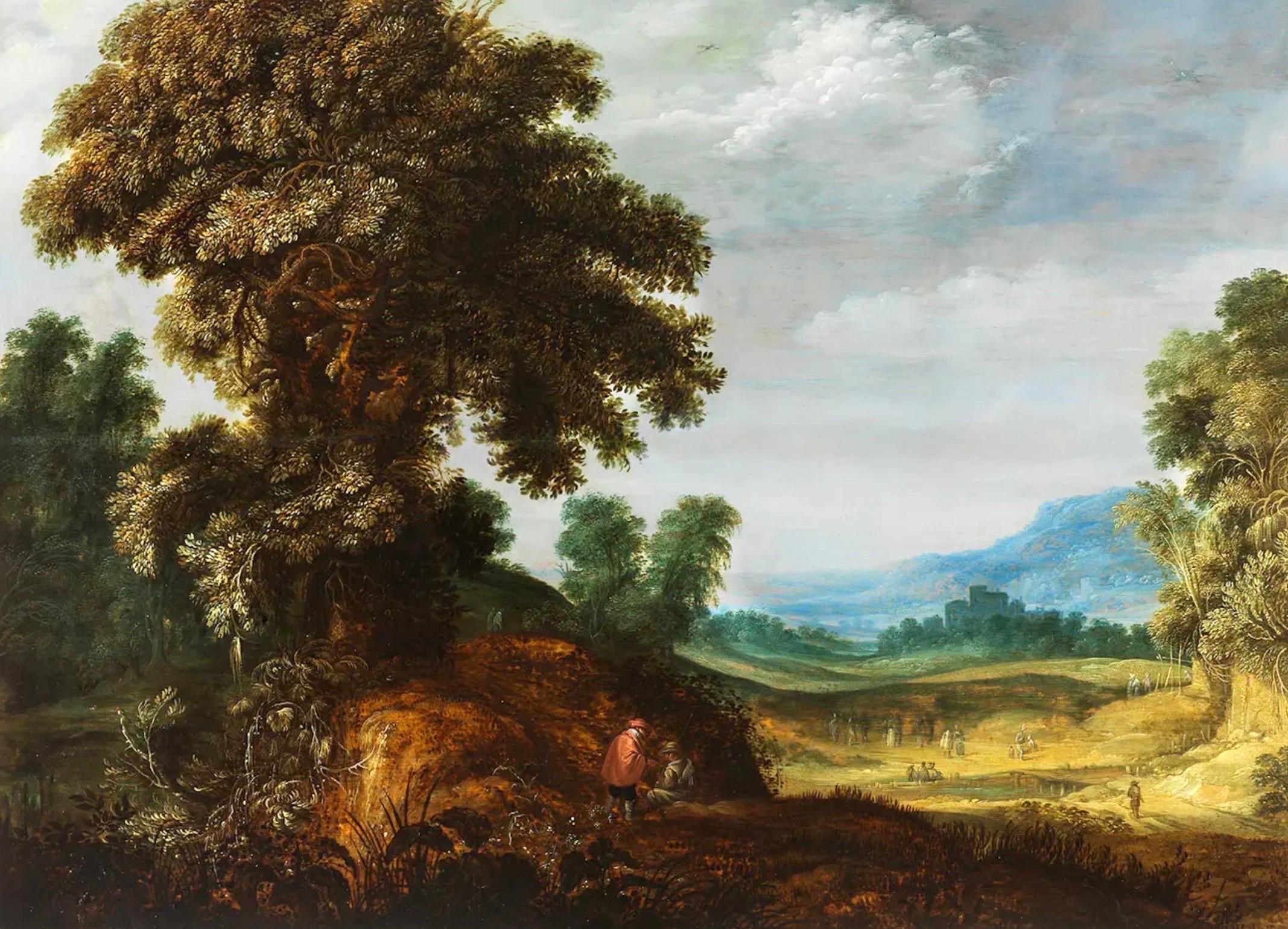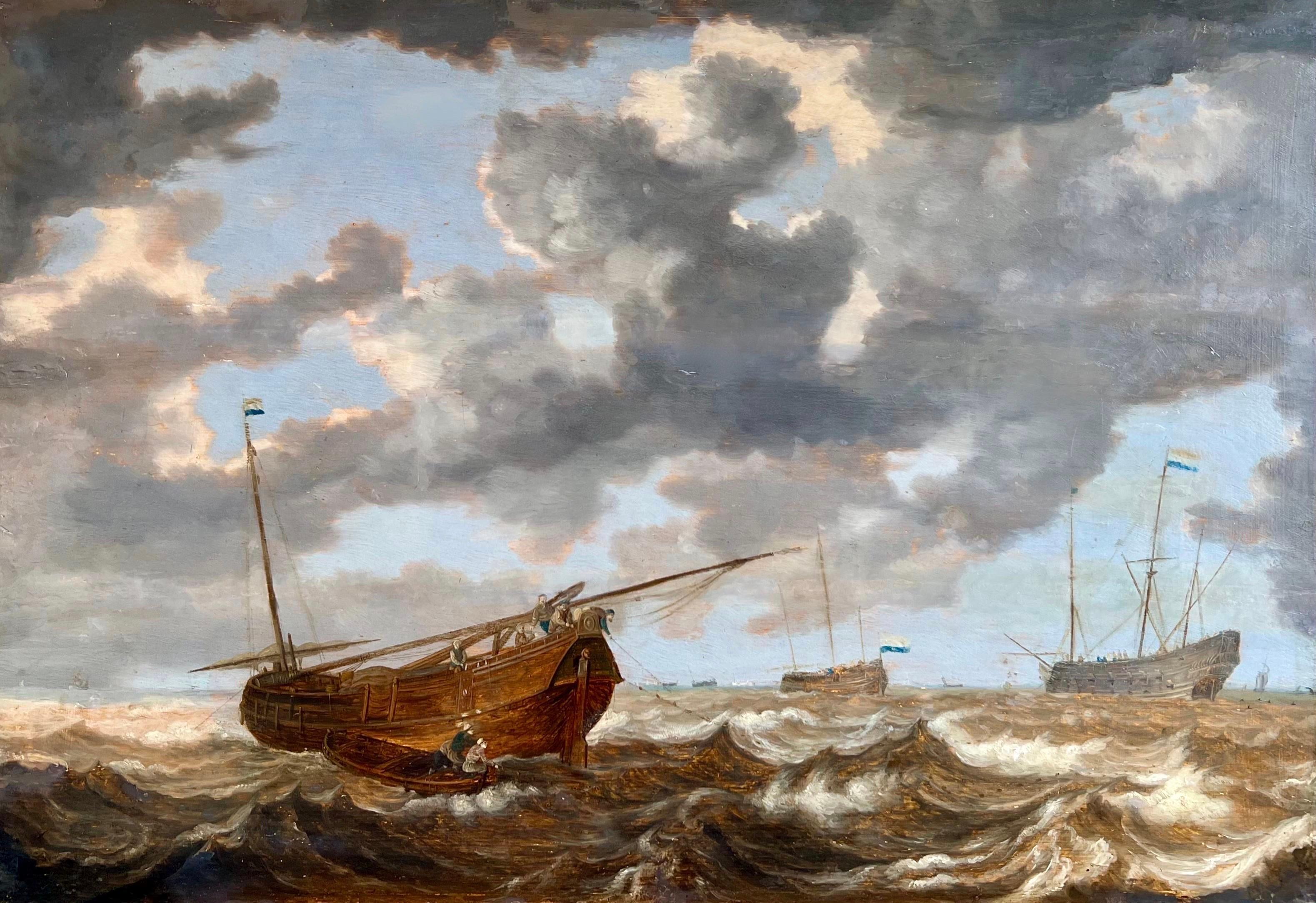Items Similar to A Beautiful and Large Marine - A Ship in Two Positions Off Dover
Want more images or videos?
Request additional images or videos from the seller
1 of 10
William John HugginsA Beautiful and Large Marine - A Ship in Two Positions Off Dover circa 1820
circa 1820
About the Item
William John Huggins (1781-1845)
A Ship in Two Positions Off Dover
oil on canvas
Unsigned
33 x 45 inches, inc. frame
William John Huggins, of whose parents nothing is known, reputedly began life as a sailor in the East India Company, but his only known voyage was from December 1812 to August 1814, to Bombay and China, when he was listed for wages as ‘ordinary seaman’ while serving as steward to Captain Thomas Buchanan on the company ship Perseverance. Unless the ‘ordinary’ rating reflects the circumstance of a man no longer fit to do an able seaman's duty, he may never have been one, although he clearly knew his subject.
A painting of the frigate Phoenix (36 guns), under Captain W. H. Webley (later Webley-Parry), convoying seventeen ships including the Perseverance home from Madras in 1814, was reputed in the Webley-Parry family to have been his first picture, and they lent it to the Royal Naval Exhibition at Chelsea in 1891 (catalogue no. 566). By 1817, when Huggins first exhibited at the Royal Academy (at the British Institution from 1825), he had settled in London at 36 Leadenhall Street (no. 105 from 1823 or 1824), near East India House. Here he remained for the rest of his life, specializing in portraits of East India vessels for captains, owners, and others, and similar shipping and naval subjects, including in watercolours.
He appears to have had some early help from Thomas Duncan (c.1779–1841), a ship decorator, print colourist, and art teacher whose son, Edward Duncan (1803–1882), a member of the Old Watercolour Society, subsequently collaborated with him as a lithographer. Edward reproduced about 150 of Huggins's works, acquired skill as a marine painter from him, and in 1834 married his eldest daughter, Berthia (1809–1884). Huggins and Duncan also occasionally painted pictures together, such as one of Indiamen in the China Sea, now in the National Maritime Museum, Greenwich, which is signed by both.
Huggins's Eastern sketches provided authentic backgrounds to his work, although he is also likely to have used other people's. He was a competent ship portraitist with a distinctive smooth finish to his oils and rather silvery, muted colour, and his work provides an important record of the shipping of his time.
On 20 September 1830, Huggins was appointed marine painter to William IV (the ‘sailor king’), who according to Redgrave ‘esteemed his work rather for its correctness than its art’ and commissioned three large paintings of the battle of Trafalgar from him. The first two were shown publicly at Exeter Hall in 1834, the third at the British Institution in 1837: all remain in the Royal Collection.
His works still often appear in the market, fetching substantial prices from collectors, and there are twenty-six in the National Maritime Museum. This also holds drawings, watercolours, prints, and two ship portraits by James Miller Huggins (bap. 1807), who was his son and pupil; he exhibited at the Society of British Artists, 1826–30, once at the British Institution in 1842, and was still working in 1865. He and another son, John W. Huggins (bap. 1809), also etched a number of Huggins's shipping studies published between 1824 and 1833 (later gathered in bound form as ‘Huggins' Marine Sketches’, n.d.). Huggins died on 19 May 1845, aged sixty-four. A letter of 1951 in the National Maritime Museum, London, suggests family papers were carelessly destroyed.
Huggins and his wife, Berthia (a name also spelt Berthier), had three other daughters, Elizabeth Mary (bap. 1813), Amelia, later Gibbs (bap. 1817), and Sarah Christiana (bap. 1821). His will, dated 1841 and proved on 12 August 1845, made them his beneficiaries, appointing the last two and his widow as executors, with directions to ‘sell by public auction all my sketches drawings and paintings’, but retaining his stock of engraved plates to reissue for joint benefit. Neither his daughter Berthia nor his sons are mentioned.
- Creator:William John Huggins (1781 - 1845)
- Creation Year:circa 1820
- Dimensions:Height: 33 in (83.82 cm)Width: 45 in (114.3 cm)
- Medium:
- Movement & Style:
- Period:
- Condition:
- Gallery Location:London, GB
- Reference Number:1stDibs: LU67337313432
About the Seller
5.0
Vetted Seller
These experienced sellers undergo a comprehensive evaluation by our team of in-house experts.
Established in 1990
1stDibs seller since 2017
40 sales on 1stDibs
Typical response time: 4 hours
- ShippingRetrieving quote...Ships From: London, United Kingdom
- Return PolicyA return for this item may be initiated within 1 day of delivery.
More From This SellerView All
- Grand 19th Century English Marine Painting in Stunning LightBy John Wilson EwbankLocated in London, GBJohn Wilson Ewbank (1799 - 1847) Shipping in the Harbour, South Shields Oil on canvas 39.5 x 58 inches unframed 47.75 x 66.5 inches framed Provenance: Christie's October 2002; Lot 11. Fine Art Society; Private Collection This marvellous up to scale Ewbank is full of light and warmth and almost certainly his greatest work of the sort rarely - if ever - seen on the market. John W. Ewbank (4 May 1799–28 November 1847), was an English-born landscape and marine painter largely operational from Scotland. The Humber river is a large tidal estuary on the east coast of Northern England. Life Ewbank was born at Darlington on 4 May 1799, the son of Michael Ewbank, an innkeeper. He was adopted as a child by a wealthy uncle who lived at Wycliffe, on the banks of the River Tees, in the North Riding of Yorkshire. Intended for the Roman Catholic priesthood, he was sent to Ushaw College, from which he absconded. In 1813 Ewbank was apprenticed to Thomas Coulson, an ornamental painter in Newcastle. In around 1816 he moved with Coulson to Edinburgh, where he had some lessons with Alexander Nasmyth. He found work both as a painter and a teacher. He was nominated in 1830 one of the foundation members of the Royal Scottish Academy. In 1833 he is listed as living at 7 Union Street on the eastern fringe of the New Town in Edinburgh. Works His sketches from nature were especially admired, and a series of 51 drawings of Edinburgh by him were engraved by W. H. Lizars for James Browne's Picturesque Views of Edinburgh (1825). He also made a reputation with cabinet pictures of banks of rivers, coast scenes, and marine subjects. As an illustrator he illustrated some early editions of Scott's Waverley Novels and one edition of Gilbert White...Category
19th Century Old Masters Figurative Paintings
MaterialsOil
- 18th Century English Oil Landscape Painting: Elegant Figures alongside River WyeBy Attributed to William MarlowLocated in London, GBAttributed to William Marlow (English, 1740-1813) Elegant Figures alongside the River Wye 1790 131 x 152 cm, inc. frame This quiet bucolic scene shows figur...Category
Late 18th Century Old Masters Figurative Paintings
MaterialsCanvas, Oil
- Monumental 17th Century Landscape Painting with Figures in an Arcadian settingLocated in London, GBEnormous 17th Century Italian landscape with figures in Arcadia. Unframed at present. Excellent condition.Category
17th Century Old Masters Landscape Paintings
MaterialsOil
- 17th Century Classical Oil Painting - Diana With Her Attendants in a GrottoBy Abraham van CuylenborchLocated in London, GBAbraham van CUYLENBROCH (1620-1658) Diana With Her Attendants in a Grotto 1651 signed oil on panel 12.2 in x 15.7 inches, inc. frame; 31 x 40 cm Provenance: Sale of Sotheby's Lo...Category
17th Century Old Masters Figurative Paintings
MaterialsOil
- 18th Century Neoclassical Oil Painting of the Trojan War: Briseis & AchillesBy James ThornhillLocated in London, GBJames Thornhill (1674-1735) Oil on canvas 12 x 14 inches; 16 ½ x 18 ½ in. Inc. frame The subject matter and inclusion of herms on both sides shows the influence of Louis...Category
Early 18th Century Old Masters Figurative Paintings
MaterialsOil, Canvas
- 19th Century French Oil Painting Algeria - Capture of the Smalah of Abd el KaderBy Émile Jean-Horace VernetLocated in London, GBCircle of Emile Jean Horace Vernet (1789-1863) The Capture of the Smalah of Abd el Kader oil on canvas 48 x 55 1/2 in; 121 x 141 cms (including magnificent contemporary carved frame) Provenance Private collection, United States This important and impressive work records the historic skirmish in 1843 between a cavalry unit lead by the duc de Aumale and the Arab chief Abd el Kader during the French military campaign in Algeria. The painting is attributed to Horace Vernet, and relates closely to a major work of the same subject by Vernet now in the Musée de l'Histoire de France in Versailles. The work is a classic example of French Orientalist painting...Category
Mid-19th Century Old Masters Figurative Paintings
MaterialsOil
You May Also Like
- Travellers and Carriage in Landscape Dutch 17th century Golden Age oil paintingLocated in London, GBThis superb Dutch Old Master Golden Age oil painting is attributed to Pieter Bodding van Laer. Painted circa 1635 the composition is a group of travellers who have stopped to rest. I...Category
17th Century Old Masters Landscape Paintings
MaterialsOil
- Amsterdam Harbour Scene with Figures Dutch 17th Century art marine oil paintingLocated in London, GBThis superb Dutch 17th century Golden Age Old Master cityscape oil painting of Amsterdam is by noted artist Jacobus Storck. Painted circa 1670, ...Category
17th Century Old Masters Landscape Paintings
MaterialsOil
- 17th century Flemish Old Master painting - Vast landscape with a majestic oakLocated in Antwerp, BE17th century Flemish old master painting depicting a forest landscape with a majestic oak Alexander Keirincx, born around 1600 in Antwerp, Belgium, was a prominent Flemish landscape...Category
17th Century Old Masters Landscape Paintings
MaterialsOil, Panel
- 17th Century by Simone Cantarini Adoration of The Magi Painting Oil on CanvasLocated in Milano, LombardiaSimone Cantarini (Pesaro 1612 - Verona 1648) Adoration of the Magi Oil on paper applied to canvas, cm. 16,5 x 24 – with frame cm. 22 x 29 Antique sh...Category
Early 17th Century Old Masters Figurative Paintings
MaterialsCanvas, Cotton Canvas, Oil
- 17th century Dutch seascape - Stormy sea with a Dutch Hoy - Marine BoatsLocated in Antwerp, BE17th century Dutch old master oil seascape, Stormy sea with boats including a Dutch Hoy and a Packet-Boat The present painting is a peaceful, yet very lively, seascape and a beautif...Category
17th Century Old Masters Landscape Paintings
MaterialsOil, Panel
- The Departure of the Vendéens, an oil on carboard by Pierre-Paul Prud'honBy Pierre-Paul Prud'honLocated in PARIS, FRProvenance: Alfred Stevens Collection Sold by Madame Blanc on May 3, 1876 (number 24 representing The Departure of the Vendéens, FRF 510, bought back by Madame Blanc). Paul Touzet (...Category
1790s Old Masters Figurative Paintings
MaterialsOil, Cardboard
Recently Viewed
View AllMore Ways To Browse
Old Ship
Antique Old Ship
Antique Ship Painting
Antique Ship Paintings
Two Doves
Authentic Antique Frames
Elizabeth Olds
William Price
Old Master Picture
19th Century Marine Art
British Ship Painting
William Ship Painting
Old Master Sketch
Old Master Sketches
William Skilling Artist
William King Artist
Etched Ship
Old Master Ship





